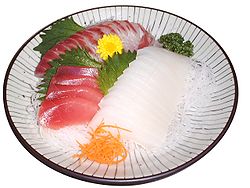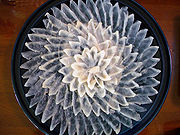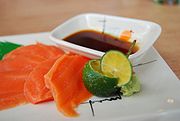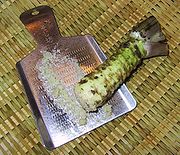
Sashimi
Encyclopedia





Japanese cuisine
Japanese cuisine has developed over the centuries as a result of many political and social changes throughout Japan. The cuisine eventually changed with the advent of the Medieval age which ushered in a shedding of elitism with the age of shogun rule...
. It consists of very fresh raw meat, most commonly fish
Fish
Fish are a paraphyletic group of organisms that consist of all gill-bearing aquatic vertebrate animals that lack limbs with digits. Included in this definition are the living hagfish, lampreys, and cartilaginous and bony fish, as well as various extinct related groups...
, sliced into thin pieces.
Origin
The word sashimi means "pierced body", i.e. "刺身 = sashimi = 刺し = sashi (pierced, stuck) and 身 = mi (body, meat).This word dates from the Muromachi period
Muromachi period
The is a division of Japanese history running from approximately 1336 to 1573. The period marks the governance of the Muromachi or Ashikaga shogunate, which was officially established in 1338 by the first Muromachi shogun, Ashikaga Takauji, two years after the brief Kemmu restoration of imperial...
, and was possibly coined when the word "切る = kiru (cut), the culinary step, was considered too inauspicious to be used by anyone other than Samurai
Samurai
is the term for the military nobility of pre-industrial Japan. According to translator William Scott Wilson: "In Chinese, the character 侍 was originally a verb meaning to wait upon or accompany a person in the upper ranks of society, and this is also true of the original term in Japanese, saburau...
. This word may derive from the culinary practice of sticking the fish's tail and fin to the slices in identifying the fish being eaten.
Another possibility for the name could come from the traditional method of harvesting. 'Sashimi Grade' fish is caught by individual handline. As soon as the fish is landed, its brain is pierced with a sharp spike; and it is placed in slurried ice. This spiking is called the Ike jime
Ike jime
or is a method of paralyzing and bleeding fish to maintain its quality. The technique originated in Japan, but is now in widespread use. It involves the insertion of a spike quickly and directly into the hind brain, thereby causing immediate brain death. A fish brain is usually located slightly...
process. The flesh contains minimal lactic acid because it died instantly so it will keep fresh on ice for about ten days, without turning white or otherwise degrading.
The word sashimi has been integrated into the English language
English language
English is a West Germanic language that arose in the Anglo-Saxon kingdoms of England and spread into what was to become south-east Scotland under the influence of the Anglian medieval kingdom of Northumbria...
and is often used to refer to other uncooked fish preparations. Many non-Japanese use the terms sashimi and sushi
Sushi
is a Japanese food consisting of cooked vinegared rice combined with other ingredients . Neta and forms of sushi presentation vary, but the ingredient which all sushi have in common is shari...
interchangeably, but the two dishes are actually distinct and separate. Sushi refers to any dish made with vinegared rice; and, while raw fish is one traditional sushi ingredient, many sushi dishes contain seafood that has been cooked, and others have no seafood at all.
Serving
Sashimi often is the first course in a formal Japanese meal, but it can also be the main course, presented with riceRice
Rice is the seed of the monocot plants Oryza sativa or Oryza glaberrima . As a cereal grain, it is the most important staple food for a large part of the world's human population, especially in East Asia, Southeast Asia, South Asia, the Middle East, and the West Indies...
and miso soup
Miso soup
is a traditional Japanese soup consisting of a stock called "dashi" into which is mixed softened miso paste. Many ingredients are added depending on regional and seasonal recipes, and personal preference.-Miso paste:...
in separate bowls. Many Japanese people believe that sashimi, traditionally considered the finest dish in Japanese cuisine, should be eaten before other strong flavors affect the palate
Palate
The palate is the roof of the mouth in humans and other mammals. It separates the oral cavity from the nasal cavity. A similar structure is found in crocodilians, but, in most other tetrapods, the oral and nasal cavities are not truly separate. The palate is divided into two parts, the anterior...
. Culinarily, sashimi represents the Japanese cultural appreciation of subtlety. The finer sensation can vary from salmon
Salmon
Salmon is the common name for several species of fish in the family Salmonidae. Several other fish in the same family are called trout; the difference is often said to be that salmon migrate and trout are resident, but this distinction does not strictly hold true...
(not traditionally Japanese) to squid
Squid
Squid are cephalopods of the order Teuthida, which comprises around 300 species. Like all other cephalopods, squid have a distinct head, bilateral symmetry, a mantle, and arms. Squid, like cuttlefish, have eight arms arranged in pairs and two, usually longer, tentacles...
and everything in between.
The sliced seafood that composes the main ingredient is typically draped over a garnish. The typical garnish is Asian white radish, daikon, shredded into long thin strands, accompanied by one green perilla
Perilla
Perilla is the common name of the herbs of the genus Perilla of the mint family, Lamiaceae. In mild climates, the plant reseeds itself. There are both green-leafed and purple-leafed varieties, which are generally recognized as separate species by botanists. The leaves resemble stinging nettle...
leaf per slice.
Wasabi paste is sometimes mixed directly into soy sauce as a dipping sauce, which is generally not done when eating sushi
Sushi
is a Japanese food consisting of cooked vinegared rice combined with other ingredients . Neta and forms of sushi presentation vary, but the ingredient which all sushi have in common is shari...
, however. Purists denounce the practice of mixing wasabi into soy sauce, saying that this dilutes the sharp hot flavor of wasabi. Another more correct way to flavor soy sauce with wasabi is to place the wasabi mound into the soy sauce dish and then pour it in. This allows the wasabi to infuse the soy sauce more subtly. A reputed motivation for serving wasabi with sashimi (and also gari
Gari (ginger)
is a type of tsukemono . It is sweet, thinly sliced young ginger that has been marinated in a solution of sugar and vinegar. Gari is often served and eaten after sushi, and is sometimes called sushi ginger...
, pickled ginger), besides its flavor, is killing harmful bacteria and parasites that could be present in raw seafood.
Sashimi is normally served only with a dipping sauce (soy sauce
Soy sauce
Soy sauce is a condiment produced by fermenting soybeans with Aspergillus oryzae or Aspergillus sojae molds, along with water and salt...
with wasabi
Wasabi
, also known as Japanese horseradish, is a member of the Brassicaceae family, which includes cabbages, horseradish, and mustard. Its root is used as a condiment and has an extremely strong flavor. Its hotness is more akin to that of a hot mustard rather than the capsaicin in a chili pepper,...
paste or such condiments as grated fresh ginger
Ginger
Ginger is the rhizome of the plant Zingiber officinale, consumed as a delicacy, medicine, or spice. It lends its name to its genus and family . Other notable members of this plant family are turmeric, cardamom, and galangal....
, or ponzu
Ponzu
is a citrus-based sauce commonly used in Japanese cuisine. It is tart, with a thin, watery consistency and a light yellow color. Ponzu shōyu or ponzu jōyu is ponzu sauce with soy sauce added, and the mixed product is widely referred to as simply ponzu.The element pon arrived in the Japanese...
), and such garnishes as shiso
Perilla
Perilla is the common name of the herbs of the genus Perilla of the mint family, Lamiaceae. In mild climates, the plant reseeds itself. There are both green-leafed and purple-leafed varieties, which are generally recognized as separate species by botanists. The leaves resemble stinging nettle...
and shredded daikon
Daikon
Daikon , Raphanus sativus var. longipinnatus, also called White Radish, Japanese radish, Oriental radish, Chinese radish, lo bok and Mooli , is a mild flavoured, very large, white East Asian radish...
radish. Dimensions vary but are typically about 2.5 cm (1") wide by 4 cm (1.5") long by 0.5 cm (0.2") thick.
Varieties
See also: List of sushi and sashimi ingredientsSome of the most popular main ingredients for sashimi are:
Some sashimi ingredients, such as octopus
Octopus
The octopus is a cephalopod mollusc of the order Octopoda. Octopuses have two eyes and four pairs of arms, and like other cephalopods they are bilaterally symmetric. An octopus has a hard beak, with its mouth at the center point of the arms...
, are sometimes served cooked given its chewy nature. Most seafood, such as tuna
Tuna
Tuna is a salt water fish from the family Scombridae, mostly in the genus Thunnus. Tuna are fast swimmers, and some species are capable of speeds of . Unlike most fish, which have white flesh, the muscle tissue of tuna ranges from pink to dark red. The red coloration derives from myoglobin, an...
, salmon
Salmon
Salmon is the common name for several species of fish in the family Salmonidae. Several other fish in the same family are called trout; the difference is often said to be that salmon migrate and trout are resident, but this distinction does not strictly hold true...
, and squid
Squid
Squid are cephalopods of the order Teuthida, which comprises around 300 species. Like all other cephalopods, squid have a distinct head, bilateral symmetry, a mantle, and arms. Squid, like cuttlefish, have eight arms arranged in pairs and two, usually longer, tentacles...
, are served raw.
Tataki
Tataki
Tataki , also called tosa-mi, is a manner of preparing fish or meat in Japanese cuisine. The meat or fish is seared very briefly over a hot flame or pan, briefly marinated in vinegar, sliced thinly and seasoned with ginger .The method originated in Tosa Province, now part of...
(たたき or 叩き, "pounded") is a type of sashimi. It is quickly and lightly seared outside, leaving it raw inside.
Less common, but not unusual, sashimi ingredients are vegetarian items such as yuba
Yuba (food)
Tofu skin also known as beancurd sheet, dried beancurd, paper, yuba or bean skin, is a Chinese and Japanese food product made from soybeans. During the boiling of soy milk, in an open shallow pan, a film or skin composed primarily of a soy protein–lipid complex forms on the liquid surface...
(bean curd skin) and raw red meats, such as beef
Beef
Beef is the culinary name for meat from bovines, especially domestic cattle. Beef can be harvested from cows, bulls, heifers or steers. It is one of the principal meats used in the cuisine of the Middle East , Australia, Argentina, Brazil, Europe and the United States, and is also important in...
, known as gyuunotataki, and horse
Horse meat
Horse meat is the culinary name for meat cut from a horse. It is a major meat in only a few countries, notably in Central Asia, but it forms a significant part of the culinary traditions of many others, from Europe to South America to Asia. The top eight countries consume about 4.7 million horses...
, known as basashi. Chicken
Chicken (food)
Chicken is the most common type of poultry in the world, and is prepared as food in a wide variety of ways, varying by region and culture.- History :...
"sashimi", known as toriwasa, is considered by some to be a delicacy; the French
France
The French Republic , The French Republic , The French Republic , (commonly known as France , is a unitary semi-presidential republic in Western Europe with several overseas territories and islands located on other continents and in the Indian, Pacific, and Atlantic oceans. Metropolitan France...
poulet de Bresse
Bresse (chicken)
The Bresse is a breed of chicken originating from the Bresse area of the Rhône-Alpes region of France.-Overview:The birds are highly valued for their gamey depth of flavour, yet with fine, tender flesh and delicious, clean-flowing fat. Roughly 1.2 million are raised annually, but such is the...
and its American
United States
The United States of America is a federal constitutional republic comprising fifty states and a federal district...
derivative, the blue foot chicken
Blue Foot chicken
Blue Foot Chicken is a Canadian breed of chicken bred to resemble the French chicken Poulet de Bresse, also known as "Bresse Blue".The breed is attributed to Canadian breeder Peter Thiessen of British Columbia and was later marketed in the United States by California farm manager Bob Shipley...
, are favored by many for this purpose, as, besides their taste, they are certified to be free of Salmonella
Salmonella
Salmonella is a genus of rod-shaped, Gram-negative, non-spore-forming, predominantly motile enterobacteria with diameters around 0.7 to 1.5 µm, lengths from 2 to 5 µm, and flagella which grade in all directions . They are chemoorganotrophs, obtaining their energy from oxidation and reduction...
. Chicken sashimi is sometimes slightly braised on the outside.

Kumamoto Prefecture
is a prefecture of Japan located on Kyushu Island. The capital is the city of Kumamoto.- History :Historically the area was called Higo Province; and the province was renamed Kumamoto during the Meiji Restoration. The creation of prefectures was part of the abolition of the feudal system...
, Matsumoto
Matsumoto, Nagano
is a city located in Nagano Prefecture, Japan. Matsumoto is designated as a Special City.-Outline:The new city of Matsumoto is the city comprising the mergers of the old city of Matsumoto and four villages. Matsumoto officially absorbed those villages without creating a new municipal...
, and Tohoku region
Tohoku region
The is a geographical area of Japan. The region occupies the northeastern portion of Honshu, the largest island of Japan. The region consists of six prefectures : Akita, Aomori, Fukushima, Iwate, Miyagi and Yamagata....
. It is often served sashimi-style, and can be found in restaurants in Osaka, Tokyo and other large cities in Japan.
Safety
A raw foodRaw foodism
Raw foodism is the practice of consuming uncooked, unprocessed, and often organic foods as a large percentage of the diet....
, sashimi can cause foodborne illness
Foodborne illness
Foodborne illness is any illness resulting from the consumption of contaminated food, pathogenic bacteria, viruses, or parasites that contaminate food, as well as chemical or natural toxins such as poisonous mushrooms.-Causes:Foodborne illness usually arises from improper handling, preparation, or...
because of bacteria and parasites, such as Anisakis
Anisakis
Anisakis is a genus of parasitic nematodes, which have a life cycle involving fish and marine mammals. They are infective to humans and cause anisakiasis...
simplex (Pseudoterranova decipiens). In addition, incorrectly prepared Fugu fish may contain tetrodotoxin
Tetrodotoxin
Tetrodotoxin, also known as "tetrodox" and frequently abbreviated as TTX, sometimes colloquially referred to as "zombie powder" by those who practice Vodou, is a potent neurotoxin with no known antidote. There have been successful tests of a possible antidote in mice, but further tests must be...
, a potent neurotoxin with no known antidote.
Traditionally, fish that spend at least part of their lives in brackish or fresh water were considered unsuitable for sashimi because of the possibility of parasites. For example, salmon, an anadromous fish, is not traditionally eaten straight out of the river. A study in Seattle, Washington
Seattle, Washington
Seattle is the county seat of King County, Washington. With 608,660 residents as of the 2010 Census, Seattle is the largest city in the Northwestern United States. The Seattle metropolitan area of about 3.4 million inhabitants is the 15th largest metropolitan area in the country...
, showed that all wild salmon had roundworm larvae capable of infecting people, while farm-raised salmon did not have any roundworm larvae.
Freezing is often used to kill parasites. According to European Union
European Union
The European Union is an economic and political union of 27 independent member states which are located primarily in Europe. The EU traces its origins from the European Coal and Steel Community and the European Economic Community , formed by six countries in 1958...
regulations, freezing fish at −20°C (−4°F) for 24 hours kills parasites. The U.S. Food and Drug Administration (FDA) recommends freezing at −35°C (−31°F) for 15 hours, or at −20°C (−4°F) for 7 days.
While Canada
Canada
Canada is a North American country consisting of ten provinces and three territories. Located in the northern part of the continent, it extends from the Atlantic Ocean in the east to the Pacific Ocean in the west, and northward into the Arctic Ocean...
does not federally regulate freezing fish, British Columbia
British Columbia
British Columbia is the westernmost of Canada's provinces and is known for its natural beauty, as reflected in its Latin motto, Splendor sine occasu . Its name was chosen by Queen Victoria in 1858...
and Alberta
Alberta
Alberta is a province of Canada. It had an estimated population of 3.7 million in 2010 making it the most populous of Canada's three prairie provinces...
voluntarily adhere to guidelines similar to the FDA's. Ontario
Ontario
Ontario is a province of Canada, located in east-central Canada. It is Canada's most populous province and second largest in total area. It is home to the nation's most populous city, Toronto, and the nation's capital, Ottawa....
attempted to legislate freezing as part of raw food handling requirements, though this was soon withdrawn due to protests by the industry that the subtle flavours and texture of raw fish would be destroyed by freezing. Instead, Ontario has decided to consider regulations on how raw fish must be handled prior to serving.
Some fish for sashimi are treated with carbon monoxide
Carbon monoxide
Carbon monoxide , also called carbonous oxide, is a colorless, odorless, and tasteless gas that is slightly lighter than air. It is highly toxic to humans and animals in higher quantities, although it is also produced in normal animal metabolism in low quantities, and is thought to have some normal...
to keep the flesh red for a longer time in storage. This practice can make spoiled fish appear fresh.
Intake of large amount of certain kind of fish may affect health as described in an article, Mercury in fish
Mercury in fish
Fish and shellfish concentrate mercury in their bodies, often in the form of methylmercury, a highly toxic organic compound of mercury. Fish products have been shown to contain varying amounts of heavy metals, particularly mercury and fat-soluble pollutants from water pollution...
.
Environmental concerns
The increased popularity of bluefin tuna for sashimi is reported to have brought this popular species to the verge of extinction. Farming bluefin does not help the situation, because the captive fish are not raised from spawn, but rather from small wild fish that are netted and transported to the farms, mostly in the Mediterranean.See also
- SushiSushiis a Japanese food consisting of cooked vinegared rice combined with other ingredients . Neta and forms of sushi presentation vary, but the ingredient which all sushi have in common is shari...
- SurimiSurimiSurimi is a Japanese loan word referring to a fish-based food product that has been pulverized to a thick paste and has the property of a dense and rubbery food item when cooked...
- IkizukuriIkizukuriIn Japanese cuisine, is the preparation of sashimi from a live sea animal, such as fish, shrimp, and lobster .Ikizukuri usually involves the customer selecting the animal they wish to eat from a saltwater tank. The chef, who is often a sashimi , takes the animal out of the tank, and carefully...
(live sashimi) - List of sushi and sashimi ingredients and styles
- Kuai (dish)Kuai (dish)Kuai is an Chinese dish consisting of finely cut strips of raw fish or meat, which is popular and commonly eaten in the early history and dynastic times of China...
- TiraditoTiraditoTiradito is a Peruvian dish of raw fish, similar to sashimi and carpaccio, in a spicy sauce. It reflects the influence of Japanese immigrants on Peruvian cookery, and differs from ceviche in the way in which the fish is cut, and in the lack of onions....
- List of raw fish dishes
- Mercury in fishMercury in fishFish and shellfish concentrate mercury in their bodies, often in the form of methylmercury, a highly toxic organic compound of mercury. Fish products have been shown to contain varying amounts of heavy metals, particularly mercury and fat-soluble pollutants from water pollution...

